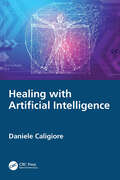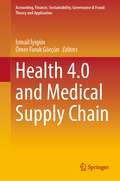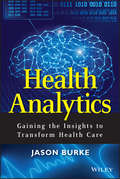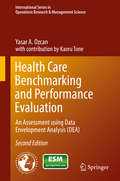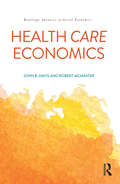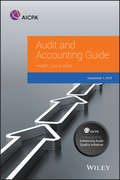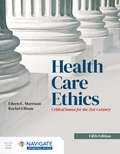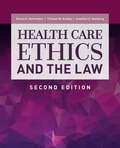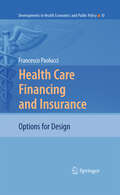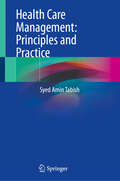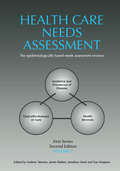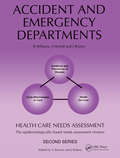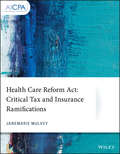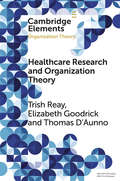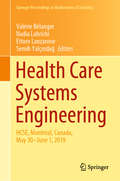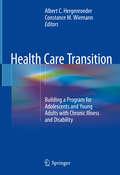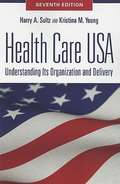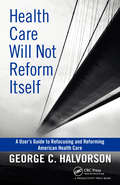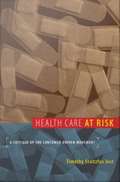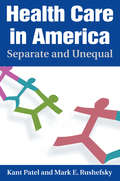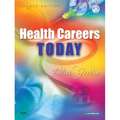- Table View
- List View
Healing with Artificial Intelligence
by Daniele CaligioreDiagnosis through images, robot surgeons, digital twins, and the metaverse are some of the applications in which artificial intelligence (AI) is involved. It is an almost sci-fi world that touches us closely and toward which we can harbor both great hopes and great fears. Health, in fact, is a central theme, and understanding how this new technology can help us to heal, acquire well-being, and live better is certainly important. This book, thanks to the author’s great experience, deals comprehensively and accessibly with the benefits and risks of using AI in the field of health. It will enable the reader to confidently approach a revolution that will change the way we treat ourselves.
Health 4.0 and Medical Supply Chain (Accounting, Finance, Sustainability, Governance & Fraud: Theory and Application)
by İsmail İyigün Ömer Faruk GörçünThis book examines the new developments in health 4.0 and the medical supply chain. Although supply chain applications in health systems are similar to other sectors, the most critical difference is that any disruption affects public health. There have been changes due to COVID-19 that caused significant disruptions in the supply chain of almost all sectors. The health sector is one of the most important sectors affected by all these extraordinary conditions. Supply chain management is even more critical because the health sector directly impacts the sustainability of human life and the provision of better living conditions. In this book, the use of artificial intelligence in the health and medical supply chain is discussed, taking into account the conditions of the post-pandemic period.
Health Analytics: Gaining the Insights to Transform Health Care
by Jason BurkeA hands-on, analytics road map for health industry leaders The industry-wide transformation taking place across the health and life sciences ecosystem is mandating that organizations adopt new decision-making capabilities, based on science and real-world information. Analytics will be a required competency for the modern health enterprise; this book is about how to "cross the chasm." The ultimate analytics guide for the health industry leader, this essential book equips business leaders with little-to-no experience in analytics to understand how to incorporate analytics as a cornerstone of their 21st century competitive business strategy. Paints the picture for a new health enterprise, one focused on the patient Explores the financial components of this new operating model, using analytics to optimize the tradeoffs between cost and value Deals with the rising role of the consumer, using analytics to create a completely new health engagement model with individual recipients of care Looks at how analytics can drive innovations in care practice, patient-experienced medical outcomes, and analytically driven novel therapies optimized for the individual patient Presents a variety of text, tables, and graphics illustrating the various concepts being described Within each section and chapter, Health Analytics assesses the current landscape, proposing a new model/concept, sharing real-world stories of how the old and new world come together, and framing a "how-to" for the reader in terms of growing that particular set of capabilities in their own enterprises.
Health Care Benchmarking and Performance Evaluation
by Yasar A. OzcanThis new edition continues to emphasize the use of data envelopment analysis (DEA) to create optimization-based benchmarks within hospitals, physician group practices, health maintenance organizations, nursing homes and other health care delivery organizations. Suitable for graduate students learning DEA applications in health care as well as for practicing administrators, it is divided into two sections covering methods and applications. Section I considers efficiency evaluations using DEA; returns to scale; weight restricted (multiplier) models; non-oriented or slack-based models, including in this edition two versions of non-controllable variable models and categorical variable models; longitudinal (panel) evaluations and the effectiveness dimension of performance evaluation. A new chapter then looks at new and advanced models of DEA, including super-efficiency, congestion DEA, network DEA, and dynamic network models. Mathematical formulations of various DEA models are placed in end-of-chapter appendices. Section II then looks at health care applications within particular settings, chapter-by-chapter, including hospitals, physician practices, nursing homes and health maintenance organizations (HMOs). Other chapters then explore home health care and home health agencies; dialysis centers, community mental health centers, community-based your services, organ procurement organizations, aging agencies and dental providers; DEA models to evaluate provider performance for specific treatments, including stroke, mechanical ventilation and perioperative services. A new chapter then examines international-country-based applications of DEA in health care in 16 different countries, along with OECD and multi-country studies. Most of the existing chapters in this section were expanded with recent applications. Included with the book is online access to a learning version of DEA Solver software, written by Professor Kaoru Tone, which can solve up to 50 DMUs for various DEA models listed in the User's Guide at the end of the book.
Health Care Economics (Routledge Advances in Social Economics)
by John B. Davis Robert McMasterThe analytical approach of standard health economics has so far failed to sufficiently account for the nature of care. This has important ramifications for the analysis and valuation of care, and therefore for the pattern of health and medical care provision. This book sets out an alternative approach, which places care at the center of an economics of health, showing how essential it is that care is appropriately recognized in policy as a means of enhancing the dignity of the individual. Whereas traditional health economics has tended to eschew value issues, this book embraces them, introducing care as a normative element at the center of theoretical analysis. Drawing upon care theory from feminist works, philosophy, nursing and medicine, and political economy, the authors develop a health care economics with a moral basis in health care systems. In providing deeper insights into the nature of care and caring, this book seeks to redress the shortcomings of the standard approach and contribute to the development of a more person-based approach to health and medical care in economics. Health Care Economics will be of interest to researchers and postgraduate students in health economics, heterodox economists, and those interested in health and medical care.
Health Care Entities, 2019 (AICPA Audit and Accounting Guide)
by AICPAConsidered the industry's standard resource, this guide will help accountants, auditors, and financial managers to understand the complexities of the specialized accounting and regulatory requirements of the health care industry. Updated for 2019, this edition has been prepared and reviewed by industry experts and provides hands-on, practical guidance for those who work in and with health care entities. A critical resource for auditors, this edition includes new accounting standards and relevant GASB and FASB updates (including those related to private companies).
Health Care Ethics
by Eileen E. Morrison Rachel EllisonFocused on today’s critical issues from an ethical standpoint, Health Care Ethics: Critical Issues for the 21st Century, Fifth Edition brings together the insights of a diverse panel of leading experts in the fields of bioethics, long-term care, and health administration, and more, to examine the key issues for individuals, organizations, and society. The early chapters of this thought-provoking book offer readers a solid understanding of healthcare ethics. They cover the fundamental principles and theories that underpin healthcare ethics. Later chapters shift the focus to the pressing issues of our time, such as autonomy, the patient's right to choose, health inequities, health inequality, COVID-19, and ethical decision-making. These chapters also introduce the ethical theories, their application, and the principles that guide them.
Health Care Ethics and the Law
by Donna K. Hammaker Thomas M. Knadig Jonathan D. GombergHealth Care Ethics and the Law is a comprehensive, practical resource designed for those preparing for a career in healthcare management. In 16 chapters, the text explains and illustrates ethical principles and their application in the real world, including material that is consistently cited by the U.S. Supreme Court and the nation’s highest appellate courts. The book also explores substantive theories of classic ethicists in the Western world, along with current scholarly literature from the nation’s leading ethicists. The authors seamlessly integrate ethical and legal concepts without overwhelming the reader with philosophies and theory. With an emphasis on interpretation, insight, and ideas, Health Care Ethics and the Law guides healthcare professionals through the ethical decisions they will face in their everyday professional lives.
Health Care Financing and Insurance
by Francesco PaolucciAs a contribution to the search for suitable and sustainable solutions to finance rising medical care expenditures, the book proposes a typology of healthcare financing and insurance schemes, based on the dimensions of basic vs. supplementary services and mandatory vs. voluntary coverage, to analyse the design and the complex interactions between various financing and insurance arrangements in several OECD countries. This study provides a better understanding of the strengths and weaknesses of the financial and organisational structures of different countries' healthcare financing and insurance schemes. Its main contributions are the development of a novel and rigorous theoretical framework analysing the economic rationales for the optimal design of healthcare financing and insurance schemes, and an empirical and institutional analysis investigating the consequences for efficiency and affordability of the complex interactions between basic and supplementary sources of financing.
Health Care Management: Principles and Practice
by Syed Amin TabishIn an era of rapid advancements, "Healthcare Management" explores the transformative journey of modern healthcare. This book covers a broad spectrum of topics, from the evolution of healthcare systems around the world and the epidemiological perspectives of healthcare management to the intricate aspects of health policy, planning, and economics. The book examines emerging trends in healthcare needs assessment, public-private partnerships, and evidence-based medicine, offering critical insights into modern management practices. Healthcare reforms are discussed with a focus on professional regulation, law and ethics. Gain insights into the latest scientific discoveries and research methodologies that are pushing the boundaries of what is possible in healthcare. Learn about the collaborative efforts that are accelerating medical breakthroughs and translating research into practice. Anticipate the future of healthcare with expert analyses on the integration of artificial intelligence, personalized medicine, telehealth, medical ethics, health services accreditation, organ transplant and patient-centered care models. "Healthcare Management" is an essential resource for healthcare professionals, administrators, academic administrators, teachers and students who are keen to stay ahead in a rapidly changing field. It provides the knowledge and tools to navigate the complexities of modern healthcare and drive meaningful improvements in patient care and system management, ultimately guiding readers towards establishing world-class healthcare systems and universities.
Health Care Nation: The Future Is Calling and It's Better Than You Think
by Tom LawryWhether a patient, health consumer, physician, nurse, health executive, or elected official, somewhere deep in our brains is this simple truth: the American health system isn’t working, and it will only get worse if we don’t do something about it.Despite spending more money per capita on health care than any other country in the world, the United States struggles to match other nations in life expectancy, health outcomes, and general well‑being. Meanwhile, the system spends more on unnecessary, ineffective, and wasteful services than what we collectively invest in K–12 education in America. All the while, our health status is declining.This is a book about the interconnectedness between the health of people and the health of a nation. It’s about the opportunity and responsibility each of us has to reimagine and reengineer a system that focuses on keeping all citizens healthy and caring for them when they are not.We can and must take back the right we all have to be in better control of things that impact our health and well‑being. This book awakens readers to the possibilities that exist today that are right in front of us if only we choose to see them.This book is for those who want to change American health care from what it is to what they believe it should be.
Health Care Needs Assessment, First Series, Volume 2, Second Edition: The Epidemiologically Based Needs Assessment Reviews, V. 2, First Series
by Jonathan Mant Andrew Stevens James Raftery Sue SimpsonHealth care needs assessment provides information to plan, negotiate and change services for the better, and to improve health in other ways. The first edition of this series established itself as a key source on health care needs for specific conditions supported by the Department of Health. Now in its second edition it provides vital updates taking into account how health care has moved on and how the structure of the UK's health service has changed. Each of the chapters follows the same structure; each analysing its topic, reviewing the incidence and prevalence, the range of services available, and the effectiveness of those services. It describes the central role and aim of health care needs assessment in the NHS health care reforms and explains the 'epidemiological approach' to needs assessment and its effectiveness. Volume 1 includes diabetes mellitus, renal disease, stroke, lower respiratory disease, coronary heart disease, colorectal cancer, cancer of the lung, osteoarthritis affecting the hip and knee, cataract surgery and groin hernia. Volume 2 includes varicose veins and venous ulcers, benign prostatic hyperplasia, severe mental illness, Alzheimer's disease, alcohol misuse, drug misuse, learning disabilities, community child health services and contraception, induced abortion and fertility services. All health professionals, including policy makers and shapers and those assessing quality of service will find this book an essential resource.
Health Care Needs Assessment: The Epidemiologically Based Needs Assessment Review
by Andrew Stevens James RafertyIn the past 10 years spirituality and spiritual care have been much debated in professional healthcare literature, highlighting the need for a recognised definition of spiritual care to enable appropriate assessment of, and response to, spiritual issues. This accessible and highly relevant book surveys the numerous statements, guidelines and standards highlighted by these discussions, and equips healthcare professionals with the knowledge, skills and competence to provide the essence of spiritual care within their professional practice. Practical and evidence-based, this manual proves that delivery of good, professional spiritual care can build on intuitive human skills, and can be taught, learned, assessed and quantified. It gives readers the opportunity to move on from uncertainties about their role in the delivery of spiritual care by allowing them to asses and improve their understanding, skills and clinical practice in this area of care. Spiritual Care for Healthcare Professionals clearly grounds spiritual care in clinical practice. It is highly recommended for supporting academic study and encouraging healthcare practitioners to reflect on their practice and develop skills in spiritual assessment and care. Aimed at all healthcare professionals, it can be used by individual practitioners for continuing professional development as well as by academic staff developing educational programmes.
Health Care Needs Assessment: The Epidemiologically Based Needs Assessment Reviews
by Andrew Stevens P.R. CroftThis volume, focusing on low back pain, is part of a survey of health care needs for specific conditions, published on behalf of the Department of Health. This study overall considers questions such as the population's needs, the services available or unavailable to them, the effectiveness of these services, and other perspectives in disease and service areas. This is the second series of needs assessment reviews.
Health Care Policy and Value-Based Competition: Implications for Government
by Michael E. Porter Elizabeth Olmsted TeisbergGovernment has a major influence on the health care system in the U.S. State and federal policy makers set numerous rules and regulations that affect the nature of competition in health care, as well as incentives and constraints for system participants. Health care policy has been both a reflection of and a contributor to the zero-sum competition that plagues the current system. According to the authors, the fundamental flaw in U.S. health care policy is its lack of focus on patient value and absence of an overall framework to guide reforms. In this chapter, Porter and Teisberg sketch out a framework for health care reform that is centered on value for patients.
Health Care Reform Act: Critical Tax and Insurance Ramifications
by Janemarie MulveyHealth Care Reform Act: Critical Tax and Insurance Ramifications by Janemarie Mulvey, Ph.D.
Health Care Research and Organization Theory (Elements in Organization Theory)
by Trish Reay Elizabeth Goodrick Thomas D'AunnoIn this Element, we examine how organizational researchers have published articles contributing to organization theory in high quality organizational journals, and we examine how healthcare researchers have drawn on organization theory in healthcare management journals. We have two main aims in writing this Element. The first is to motivate scholars working in the field of general organizational and management studies to increasingly use healthcare settings as an empirical context for their work in theory development. Our second aim is to encourage healthcare researchers to increase their use of organizational theory to advance knowledge about the provision of healthcare services. Our investigations revealed a growing number of organizational studies situated in healthcare. We also found a disappointing level of connection between research published in organization journals and research published in healthcare journals. We provide explanations for this division, and encourage more crossdisciplinary work in the future.
Health Care Systems Engineering: HCSE, Montréal, Canada, May 30 - June 1, 2019 (Springer Proceedings in Mathematics & Statistics #316)
by Ettore Lanzarone Valérie Bélanger Nadia Lahrichi Semih YalçındağThis book presents the proceedings of the Fourth International Conference on Health Care Systems Engineering (HCSE 2019), which took place in Montreal, Canada, from May 30 to June 1, 2019. The event took place in the mother and child university hospital CHU Sainte-Justine in Montréal, and each session was co-chaired by a discussant coming from the clinical practice.The conference offered scientists and practitioners an opportunity to discuss operations management issues in health care delivery systems, and to share new ideas, methods and technologies for improving the operation of health care organizations.Focusing on applications of systems engineering, optimization and statistics to improve health care delivery and health systems, the book covers topics relating to a broad spectrum of concrete problems that pose challenges for researchers and practitioners alike, including hospital drug logistics, operating theatre management, blood donation, home care services, modeling, simulation, process mining and data mining in patient care and health care organizations.
Health Care Transition: Building A Program For Adolescents And Young Adults With Chronic Illness And Disability
by Albert C. Hergenroeder Constance M. WiemannThis comprehensive book thoroughly addresses all aspects of health care transition of adolescents and young adults with chronic illness or disability; and includes the framework, tools and case-based examples needed to develop and evaluate a Health Care Transition (HCT) planning program that can be implemented regardless of a patient’s disease or disability. Health Care Transition: Building a Program for Adolescents and Young Adults with Chronic Illness and Disability is a uniquely inclusive resource, incorporating youth/young adult, caregiver, and pediatric and adult provider voices and perspectives. Part I of the book opens by defining Health Care Transition, describing the urgent need for comprehensive transition planning, barriers to HCT and then offering a framework for developing and evaluating health care transition programs. Part II focuses on the anatomic and neuro-chemical changes that occur in the brain during adolescence and young adulthood, and how they affect function and behavior. Part III covers the perspectives of important participants in the HCT transition process – youth and young adults, caregivers, and both pediatric and adult providers. Each chapter in Part IV addresses a unique aspect of developing HCT programs. Part V explores various examples of successful transition from the perspective of five key participants in the transition process - patients, caregivers, pediatric providers, adult providers and third party payers. Related financial matters are covered in part VI, while Part VII explores special issues such as HCT and the medical home, international perspectives, and potential legal issues. Models of HCT programs are presented in Part VIII, utilizing an example case study. Representing perspectives from over 75 authors and more than 100 medical centers in North America and Europe, Health Care Transition: Building a Program for Adolescents and Young Adults with Chronic Illness and Disability is an ideal resource for any clinician, policy maker, caregiver, or hospitalist working with youth in transition.
Health Care USA
by Harry A. Sultz Kristina M. YoungHealth Care USA, Seventh Edition, Offers Students Of Health Administration, Medicine, Public Health, And Related Fields The Most Comprehensive Overview Of America's Health Care System Under A Single Cover. Combining Historical Perspective With Analysis Of Modern Trends, This Expanded Edition Charts The Evolution Of Modern American Health Care, Providing A Complete Examination Of Its Organization And Delivery While Offering Critical Insight Into The Issues That The U. S. Health System Faces Today. From A Physician-Dominated System To One Defined By Managed Care And Increasingly Sophisticated Technology, This Essential Text Explains The Transformation Underway And The Professional, Political, Social, And Economic Forces That Guide It Today And Will In The Future. Exhaustive In Breadth And Balanced In Perspective, Health Care USA, Seventh Edition, Provides Students With A Clearly Organized, Straightforward Illustration Of The Complex Structures, Relationships And Processes Of This Rapidly Growing, $2. 5 Trillion Industry. The Seventh Edition Has Been Thoroughly Revised To Reflect Recent Developments In This Dynamic Industry. The Latest Edition Features: - A Comprehensive Overview Of The Complex And Evolving U. S. Health Care System, Plus Revised Data, Material And Analysis Throughout. - The Latest Benchmark Developments In Health Care, Including The Response Of Public Health To Swine Flu And The Obama Administration's Health Care Reform. - A Look At The Recent Recession's Effects On Hospital Finances. - New Projections And Data Trends On The Country's Health Care Spending. - A Forward-Looking Perspective On The Future Of The U. S. Health Care System.
Health Care Will Not Reform Itself: A User's Guide to Refocusing and Reforming American Health Care
by George C. HalvorsonHealth care reform is within our reach. According to George Halvorson, CEO of the nation's largest private health care plan, only by improving the intent, quality, and reach of services will we achieve a health system that is economically feasible into the future. &nb
Health Care at Risk: A Critique of the Consumer-Driven Movement
by Timothy Stoltzfus JostIn Health Care at Risk Timothy Stoltzfus Jost, a leading expert in health law, weighs in on consumer-driven health care (CDHC), which many policymakers and analysts are promoting as the answer to the severe access, cost, and quality problems afflicting the American health care system. The idea behind CDHC is simple: consumers should be encouraged to save for medical care with health savings accounts, rely on these accounts to cover routine medical expenses, and turn to insurance only to cover catastrophic medical events. Advocates of consumer-driven health care believe that if consumers are spending their own money on medical care, they will purchase only services with real value to them. Jost contends that supporters of CDHC rely on oversimplified ideas about health care, health care systems, economics, and human nature. In this concise, straightforward analysis, Jost challenges the historical and theoretical assumptions on which the consumer-driven health care movement is based and reexamines the empirical evidence that it claims as support. He traces the histories of both private health insurance in the United States and the CDHC movement. The idea animating the drive for consumer-driven health care is that the fundamental problem with the American health care system is what economists call "moral hazard," the risk that consumers overuse services for which they do not bear the cost. Jost reveals moral hazard as an inadequate explanation of the complex problems plaguing the American health care system, and he points to troubling legal and ethical issues raised by CDHC. He describes how other countries have achieved universal access to high-quality health care at lower cost, without relying extensively on cost sharing, and he concludes with a proposal for how the United States might do the same, incorporating aspects of CDHC while recognizing its limitations.
Health Care in America: Separate and Unequal
by Mark E Rushefsky Kant PatelThe American health care system is a unique mix of public and private programs that critics argue has produced a two-tier system - one for the rich and the other for the poor - that delivers dramatically unequal care and leaves millions of Americans seriously underinsured or with no coverage at all. This book examines the root causes of the inequalities of the American health care system and discusses various policy alternatives. It systematically documents the demands on and the performance of our health care system for different population groups as defined on the basis of gender (women), age (children), race and ethnicity (African Americans, Hispanics, Native Americans), and residence in high poverty areas (rural and inner city locales).For each population, the book documents: historical and demographic profile, data on health status, aspects of inequality including access; quality of care; and endemic, cultural, and lifestyle issues affecting health; policies, laws, and programs relevant to health care; and, indicators of improvement or negative trends.
Health Care in the Next Curve: Transforming a Dysfunctional Industry
by John AbendshienHealthcare in the U.S. is a critical juncture. We face a sharp upward rise in the number of people with chronic diseases and disabilities. As demands on our current health system grow, so will costs. But as a society we are approaching the upper limit of how much we are willing (or able) to spend on health care. Health care policy makers know this. That is why major health reform measures are focused on population health and value-based care. These are the so-called second curve objectives. But these initiatives are doomed to failure. We are asking a system to do things that it was not designed to do. In fact, we don’t have a health care "system" as such. We have a parts bin of disconnected silos. Fragmented delivery systems. Specialized caregivers. Professional groups. Trade associations. All with distinct cultures. Each with their own motivations and agendas. Our payer and regulatory structures have evolved over the decades in response to political and policy initiatives. However well intentioned (or not), these structures defy logic. They reward and reinforce counter-productive industry behaviors. They pose formidable roadblocks to achieving needed changes. Current reform initiatives are an implicit recognition that our health model is flawed. The attitude seems to be, "Yes, we know the overall health system is a problem, but we can make failure less severe if we implement these measures." We are at a critical juncture. We can continue to place additional demands on an industry model that has outlived its functional utility. Or we can take more of a clean slate approach and move toward a model that is in keeping with today’s needs. The outlook is not good if we stay on the current curve. The demands on resources will continue their upward trajectory. The default scenario will be one of rationing and less to invest in new cures and new technologies. The good news is that we are within sight of a future state of health care that can really work. In this future state, we have gotten rid of the artificial barriers to effective and efficient patient care. Physicians and other health professionals work in a coordinated, inter-disciplinary fashion. They have accountability for the whole care cycle. Caregivers have both the flexibility and encouragement to innovate and come up with optimal delivery approaches. And because they are in a risk-reward relationship with payers, they have the incentives to provide true value. Patients feel intimately connected to a system that is focused on their specific needs. The key to this future state is good old-fashioned market discipline. Other delivery models must either improve or get out of the way. The market will demand cost-efficiencies and won’t tolerate waste. Much of our regulatory structure will be rendered unnecessary. There will be not rewards for poor performance. This book takes a unique macro-level perspective of clinical, economic, and regulatory problems and possible solutions. It takes an objective and something scathing look at current industry structure: a silo-driven culture and entrenchment that is driven by self-interest; as well as the complicity of government in preserving the status quo through regulations, licensure, payment systems, etc.
Health Careers Today
by Judith GerdinCovering more than 45 health careers, this book offers a practical overview to help students make an informed decision in choosing a profession. Not only does it discuss the roles and responsibilities of various occupations, it provides a solid foundation in the skills needed for all health careers. Clear explanations of anatomy and physiology provide essential knowledge of health related to the human body, and show how this applies to different careers. Content in the book now adheres to and reflects National Health Care Skills Standards. A clear writing style makes it easy for students to explore health career options. Health career discussions include the requirements and roles and responsibilities of each. Full-color drawings and photographs illustrate concepts, techniques, and equipment. Summaries of essential points introduce new concepts and help with exam preparation. Anatomy and Physiology unit covers all of the body systems, and applies A&P to practice. Skill Activities provide the opportunity to obtain hands-on experience. Learning Objectives at the beginning of each chapter help readers focus on key information. Key Terms with definitions are listed at the beginning of each chapter. Core concepts are reinforced with more than 70 content boxes, skill boxes, review questions, and critical thinking questions. A comprehensive glossary includes all key terms and definitions for quick reference. The companion CD-ROM has been completely revised, now including over 20 all-new skills videos, animations, chapter-specific quizzes, and an audio glossary. NEW Culture and Health Care chapter provides information on cultural and religious diversity as required by the National Health Care Skills Standards (NHCSS), including strategies that various cultures use to solve health-related problems, clients and patients who use English as a second language, and the awareness of religious diversity as it relates to client care. NEW Standards and Accountabilities section appears at the end of appropriate chapters, with the specific number and name of each national standard covered, along with its page number, so that correlations can be found quickly and easily. Revised Interpersonal Dynamics and Communication chapter now includes information on team-building, goal-setting, evaluation, and traits of leaders and team members. NEW chapter summaries review and identify vital content covered in each chapter. Seven new skills have been added, offering additional hands-on experience.
